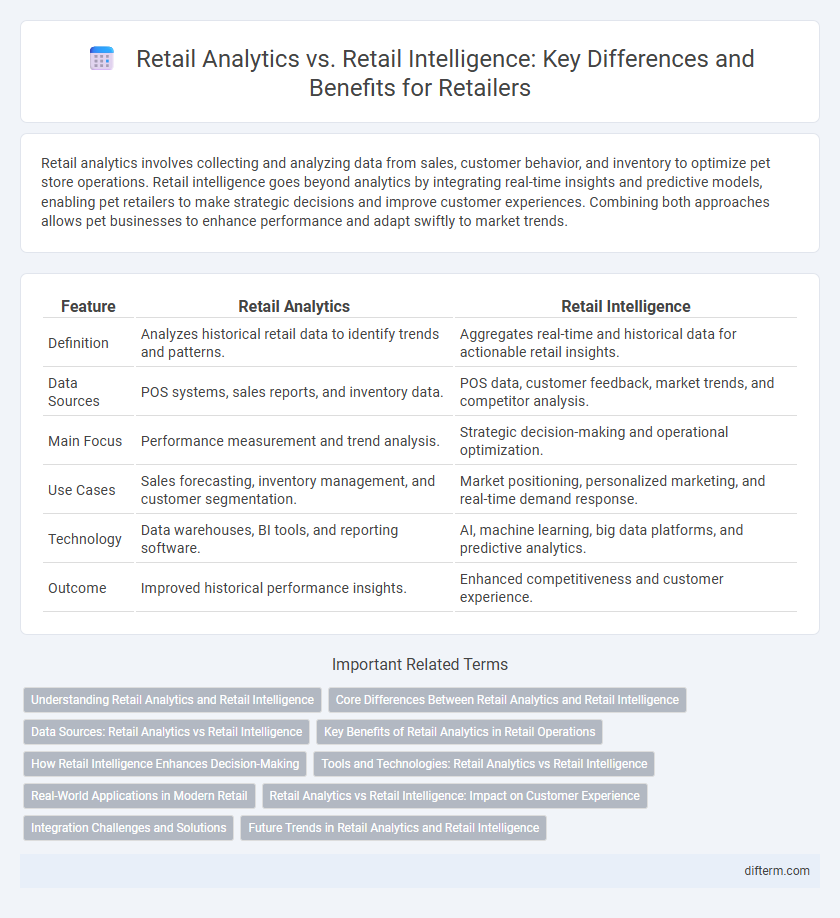Retail analytics involves collecting and analyzing data from sales, customer behavior, and inventory to optimize pet store operations. Retail intelligence goes beyond analytics by integrating real-time insights and predictive models, enabling pet retailers to make strategic decisions and improve customer experiences. Combining both approaches allows pet businesses to enhance performance and adapt swiftly to market trends.
Table of Comparison
| Feature | Retail Analytics | Retail Intelligence |
|---|---|---|
| Definition | Analyzes historical retail data to identify trends and patterns. | Aggregates real-time and historical data for actionable retail insights. |
| Data Sources | POS systems, sales reports, and inventory data. | POS data, customer feedback, market trends, and competitor analysis. |
| Main Focus | Performance measurement and trend analysis. | Strategic decision-making and operational optimization. |
| Use Cases | Sales forecasting, inventory management, and customer segmentation. | Market positioning, personalized marketing, and real-time demand response. |
| Technology | Data warehouses, BI tools, and reporting software. | AI, machine learning, big data platforms, and predictive analytics. |
| Outcome | Improved historical performance insights. | Enhanced competitiveness and customer experience. |
Understanding Retail Analytics and Retail Intelligence
Retail analytics involves the systematic examination of customer data, sales patterns, and inventory to optimize merchandising and pricing strategies. Retail intelligence integrates these insights with market trends and competitor analysis to support strategic decision-making and enhance overall business performance. Understanding both concepts enables retailers to leverage data-driven insights for improved customer experiences and operational efficiency.
Core Differences Between Retail Analytics and Retail Intelligence
Retail analytics primarily involves the collection and analysis of transactional data to uncover sales trends, customer behavior, and inventory performance. Retail intelligence extends beyond analytics by integrating external data sources such as market trends, competitor activities, and consumer sentiment to provide strategic business insights. The core difference lies in retail analytics focusing on historical and operational data, while retail intelligence delivers a comprehensive, real-time overview for proactive decision-making.
Data Sources: Retail Analytics vs Retail Intelligence
Retail analytics primarily utilizes structured data from point-of-sale systems, customer loyalty programs, and inventory management platforms to analyze sales trends and consumer behavior. Retail intelligence integrates these data sources with unstructured data such as social media insights, competitor activity, and market trends for a comprehensive view of retail performance. The combination of transactional and external data enables retailers to enhance decision-making and optimize operational strategies.
Key Benefits of Retail Analytics in Retail Operations
Retail analytics enhances retail operations by providing actionable insights derived from customer behavior, sales trends, and inventory data, enabling optimized decision-making and increased profitability. It improves demand forecasting, reduces stockouts, and enhances personalized marketing strategies to drive customer engagement and loyalty. Leveraging data-driven retail analytics results in streamlined supply chain management and greater operational efficiency compared to traditional retail intelligence approaches.
How Retail Intelligence Enhances Decision-Making
Retail intelligence harnesses advanced data aggregation and real-time analytics to provide comprehensive insights into consumer behavior, inventory levels, and market trends, enabling retailers to make informed strategic decisions. By integrating data from multiple sources such as point-of-sale systems, social media, and supply chain metrics, retail intelligence offers predictive analytics that optimize pricing, merchandising, and customer engagement. This holistic approach surpasses traditional retail analytics by delivering actionable intelligence that drives operational efficiency, boosts sales, and enhances overall profitability.
Tools and Technologies: Retail Analytics vs Retail Intelligence
Retail analytics utilizes advanced data processing tools like predictive modeling, machine learning algorithms, and data visualization platforms to analyze sales patterns, customer behavior, and inventory levels. Retail intelligence integrates these analytics with real-time data sources, IoT devices, and AI-driven decision support systems to provide actionable insights for strategic business planning. Both leverage technologies such as cloud computing and big data analytics, but retail intelligence emphasizes comprehensive situational awareness through multi-source data integration and contextual understanding.
Real-World Applications in Modern Retail
Retail analytics involves collecting and analyzing historical sales data to identify trends and optimize inventory management, while retail intelligence integrates real-time data from customer behavior and market conditions to drive personalized marketing and enhance customer experience. Modern retail leverages analytics for sales forecasting and demand planning, whereas retail intelligence supports dynamic pricing and location-based promotions. Businesses combining both approaches achieve improved decision-making, increased operational efficiency, and higher customer satisfaction in competitive marketplaces.
Retail Analytics vs Retail Intelligence: Impact on Customer Experience
Retail analytics leverages data-driven insights from sales, inventory, and customer behavior to optimize store operations and personalize marketing strategies. Retail intelligence integrates real-time data and advanced technologies like AI to provide a comprehensive understanding of customer preferences and market trends, enhancing decision-making processes. The impact on customer experience is profound, with retail intelligence enabling more proactive engagement and tailored experiences compared to the reactive insights offered by retail analytics.
Integration Challenges and Solutions
Retail analytics and retail intelligence both rely on data integration, but retail intelligence faces more complex challenges due to its need for real-time, multi-source data synchronization across supply chain, customer behavior, and sales platforms. Common integration challenges include disparate data formats, inconsistent data quality, and fragmented legacy systems hindering seamless data flow. Solutions involve implementing unified data warehouses, leveraging APIs for real-time connectivity, and adopting AI-powered platforms that normalize and harmonize data for actionable retail insights.
Future Trends in Retail Analytics and Retail Intelligence
Future trends in retail analytics emphasize the integration of artificial intelligence and machine learning to deliver hyper-personalized customer experiences and optimize inventory management. Retail intelligence is evolving with real-time data processing and advanced predictive analytics, enabling retailers to anticipate market shifts and enhance competitive strategies. The convergence of Internet of Things (IoT) devices and big data analytics drives smarter decision-making, improving operational efficiency and customer engagement across retail channels.
retail analytics vs retail intelligence Infographic

 difterm.com
difterm.com